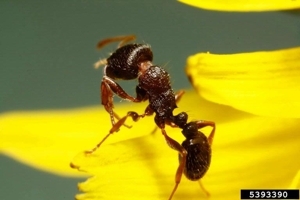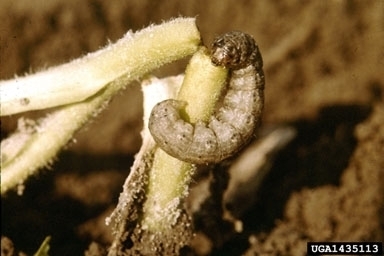Lawns: Common Insect Pests
Each year homeowners spend a great deal of time and money to establish and maintain attractive lawns only to see their efforts nullified by pests. These pests are not found in every lawn but they do occur almost every season in some part of the state. White grubs are a large problem in turf and as such have their own extensive fact sheet: Grub Problems in Turf.
Ants

Joseph Berger, Bugwood.org
Many species of ants may be present in a lawn from the 1/8” black ants to the 1/4” pavement ants. Unsightly ant mounds can cover large areas of lawns. The tunneling of ants allows the soil to dry out which may kill patches of grass. Ants will sometimes nest around the roots of a grass plant and kill it. They may prevent grass seed from germinating by feeding on it or storing it in their nests. Some ants live in association with root-feeding aphids, farming the grass so that they can, in turn, feed off of the sticky, sugary ‘honeydew’ that is secreted by the aphids.
Ant nests usually have a solitary queen but she may live up to 15 years and produce thousands of eggs. The newly hatched larvae are fed by worker ants through their many molt stages until they pupate and become adults. Most of these adults become workers but some may develop wings that allow them to swarm in the early spring and late summer (causing them to be confused with termites).
Chemical Control
If a chemical control must be used it should be a product that is registered for the use of ant control and should be applied only to the ant hills. Children and pets should be kept off of the lawn until the product has been watered in and the grass has dried.
Chinch Bugs

Chinch bugs, Blissus leucopterus hirtus (Montandon) are among the most important pests of lawns especially in the warmer areas of the state. These sucking insects are about 1/6” long when fully grown. The immature nymphs are pinkish, reddish, or brownish in color with white bands across their backs and they range in size from 1/20” to the 1/6” adult size. The adults are black with pearly-white wings.
During the winter the adults hibernate in lawns under fallen leaves or in other protected places. In the spring the adults migrate to the lawn to lay their eggs at the base of grass plants. The eggs hatch into the tiny nymphs in a week. Most of the feeding damage is caused by nymphs sucking the plant sap from the grass. The damage first appears as small yellow or brown areas (which can be mistaken for drought) that increase in size and coalesce as the injury progresses and the chinch bugs move on to new areas. The chinch bug completes its development in 30-40 days and can have 2-3 generations per year in Connecticut. These generations can overlap so that it is possible to find all stages of the insect at any time during the summer. Hot, dry weather and sunny locations favor chinch bug development.
To check for chinch bugs select a sunny spot where the grass is beginning to yellow but there is still healthy green grass. Remove both ends of a large can. Push one end of the can 2-3” into the soil at the selected spot. Fill the can with soapy water, refilling it as the water drains until it maintains 2-3” in the area above ground level. If chinch bugs are present they will float to the surface in less than 5 minutes. 20-30 chinch bugs per square foot warrant control measures.
Non-chemical Control
- Non-chemical controls include using endophyte-enhanced turf grass seed (tall fescues, fine fescues, and perennial ryegrasses are currently available). Endophytes are naturally occurring fungi that produce alkaloids that can repel chinch bugs.
- Thatch should also be kept to a minimum as it provides protection to chinch bugs.
- Proper irrigation can reduce chinch bug damage, do not over-water.
- Decrease fertilizer rates.
- Lawns should mowed frequently so that no more than 1/3 of the blade is removed.
- Sharp mower blades will reduce tearing of the grass blades thereby reducing the stress level of the plant and making it less susceptible to chinch bugs.
Chemical Control
Commercial pesticides may be used to control chinch bugs but will also affect all insects in the treated area, including beneficials and should be used judiciously. Early to mid-June is the usual application time.
Cutworm

Cutworms are the larvae (caterpillars) of several species of night-flying moths in the family Noctuidae. The larvae are called cutworms because they cut down young plants as they feed on stems at or below the soil surface. Cutworms such as the variegated cutworm and black cutworm can be serious pests of young plants. Adults and larvae are nocturnal and hide during the day but may become active during cloudy days. Some cutworms may climb up the plant and feed on unopened buds. If disturbed, the larvae may curl into a C-shaped ball. These dull colored, smooth caterpillars may become up to 1 3/4" long when fully grown.
Visually inspect plants when adults are active. Pay close attention to plants near weedy areas or near vegetable fields. Caterpillars have five or fewer pairs of prologs (fleshy protrusions seen on the abdomen) and hooks (crochets) at the tip of the prolegs that help them attach to the plant. (Sawflies have six or more pair of prologs and the adults are thick-waisted members of the bee family). It is important to distinguish between caterpillars and sawflies because management strategies differ.
Cultural Controls
- Eliminate weeds that may serve as alternate hosts.
- Clean up plant debris which may harbor overwintering pupae.
- Install insect screening to prevent entry of adults into the greenhouses.
- Barriers several inches high can be made by wrapping paper, aluminum foil, thin cardboard, or similar materials around the base of transplant stems.
Biological Controls
The commercially available egg parasitoid wasp, Trichogramma spp., lay their lay their eggs into the eggs of the cutworm moth. These mini-wasps have a rapid life cycle of about 7 to 10 days from egg to adult, so populations can increase rapidly. Timing is critical as these 1/25” small wasps only work against the egg stage and not the larval stage. Trichogramma turns the eggs of some caterpillars black. When releasing these mini-wasps, protect them from ants.
Microbial Controls
Bacillus thuringiensis spp. kurstaki, BTK, applied to the foliage as a spray, is most effective against the young actively feeding larvae. This bacterium must be consumed by the caterpillars in order to be effective, so thorough spray coverage is needed. Repeated applications are also needed, because the bacterium is susceptible to ultraviolet light degradation and may be washed off the leaves.
Sod Webworm

image by Purdue Extension
Sod webworm are the larvae of a small whitish or gray moth in the genus Herpetogramma. The larvae are light brown, usually spotted, 1/2-3/4” long and live in silk-lined tubes just below the surface of the soil. They stay in the tubes during the day and come out to feed at night or on rainy days. The larvae eat the grass at the soil level and the injury first appears as small brown spots in the lawn. As the feeding injury becomes more severe the lawn will have irregular and ragged growth patches where the grass is uneven heights. Active caterpillars will be found in such spots.
The webworm moths are most active at dusk and may be seen flying low in a slow zigzag pattern over the grass as they scatter their eggs. There are 2-4 generations per year. The presence of a severe sod webworm infestation may be indicated by flocks of birds pecking in the lawn. Sod webworm may detected following the same method as mentioned in the above chinch bug section.
Non-chemical controls
- Sod webworm control will also benefit from use of the endophytic grasses mentioned in the chinch worm section.
- Parasitic nematodes are a biological control as is Bacillus thuringiensis spp. Kurstaki, a soil borne fungus that will control young larvae.
Chemical Controls
Several insecticides are no longer available to homeowners as of 1/17 and must be applied by those with a commercial license. Be sure to follow all label directions when applying insecticides.
Despite good cultural practices, pests and diseases at times may appear. Chemical control should be used only after all other methods have failed.
For pesticide information please call UConn Home and Garden Education Center weekdays, in Connecticut call toll free 877-486-6271. Out of state call 860-486-6271
.
UConn Home and Garden Education Center, 2017
Issued in furtherance of Cooperative Extension work, Acts of May 8 and June 30, 1914, in cooperation with the U.S. Department of Agriculture, the Dean of the College, Cooperative Extension System, University of Connecticut, Storrs. The Connecticut Cooperative Extension System is an equal opportunity employer and program provider. To file a complaint of discrimination, write USDA, Director, Office of Civil Rights, Room 326-W, Whitten Building, Stop Code 9410, 1400 Independence Avenue, SW, Washington, DC 20250-9410 or call (202) 720-5964.